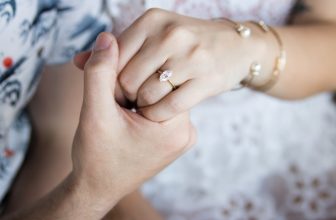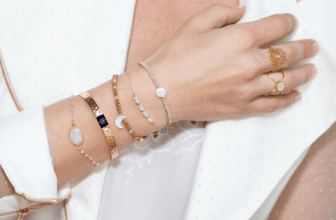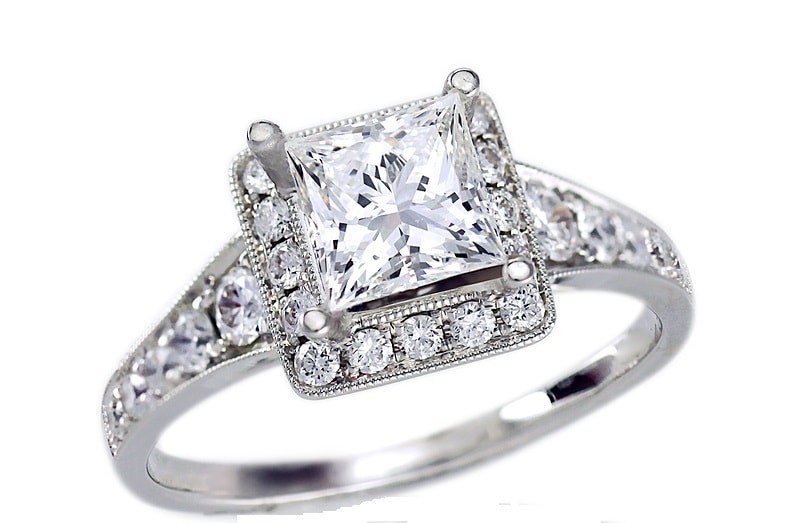
Table of Contents
Milgrain is a jewelry design detail that features tiny bead-like patterns found along the borders of the jewelry piece to add texture and beauty.
It might seem like a small detail, but it makes a big difference to the overall appearance of the jewelry design. It’s especially popular in vintage engagement rings, which is great if you like this style. If not, milgrain might not be for you.
Keep reading as we outline everything you need to know to decide if you should buy a ring with milgrain details.
What Is Milgrain?
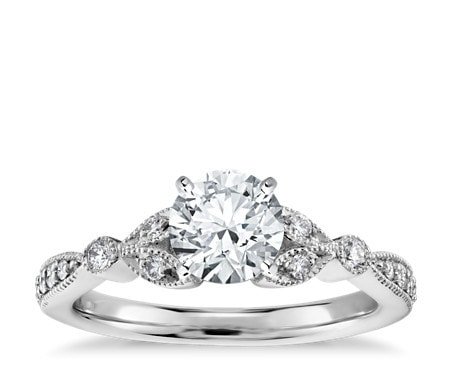
The name ‘milgrain’ (a.k.a. mille-grain, millgrain) tells us what it is, as Milgrain translates to a thousand grains in French. A perfectly suitable name when you look closely at this design element. Tiny metal beads are placed in a close-fitting row to act as a border for jewelry designs.
These little ‘grains’ can be made of any type of metal, but are typically crafted out of precious metals. Milgrain was commonly used to decorate and enhance antique and vintage jewelry.
Where Does Milgrain Come From?
Milgrain detailing has been a feature of jewelry for centuries, making appearances in styles around the globe. It was especially popular in Asia, which is credited for introducing this feature into jewelry. It was widely used in South East Asia, India and China.
It can be said that the modern popularity of milgrain has its roots in the Edwardian era, which heavily used filigree and milgrain in its designs. It cycled in and out of popularity, but later on, the Art Deco era brought back this feature along with its geometric and angular designs. Today, it’s a staple in vintage-inspired designs.
How Large are Milgrain Beads?
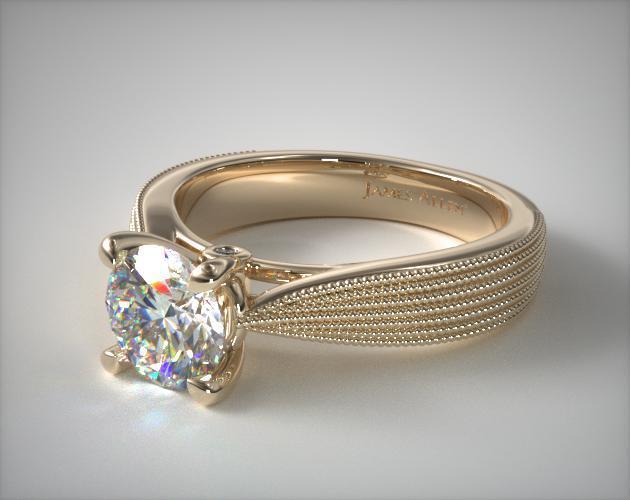
Milgrain detailing can come in a number of different sizes, from near invisible little spheres to sizeable grains. Some milgrain beads can be large enough to stand out as a feature in itself, while others are so tiny they may be invisible to the eye but you’ll feel them when you touch the edges of the ring.
The size depends on the overall design of the ring. In some cases, large and small milgrain detail can work together to create appealing designs.
While most milgrain engagement rings generally have just one row along the edges of the ring, some modern designs have whole surfaces covered in neat rows of milgrain, as demonstrated in the ring design below.
This adds texture and complexity to the ring design, giving it an intriguing appearance and making the milgrain more than just an embellishment. The ring design featured above shows row upon row of milgrain, and is the central focus of the design.
How is Milgrain Crafted?
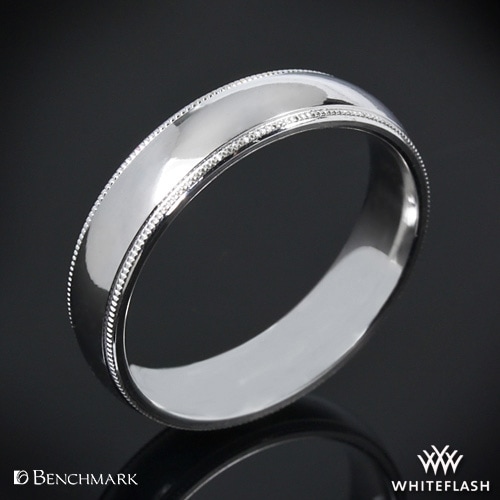
Milgrain can be created in three main ways. All three methods can result in beautiful milgrain detailing, but today, the milgrain tool and the machine created milgrain are the most common.
- Handcrafted Milgrain: One way is to first craft the tiny metal beads and then have them soldered onto the ring design. This is a painstaking and time-consuming method as each bead is individually placed into its position on the design. All antique jewelry featuring milgrain was crafted using either this or the next method. Handcrafted milgrain is not perfect, which is why the end result is unique.
- A Milgrain-Like Finish: Another way is to use a special tool that works like a mold to create the beaded pattern along the surface. This is called a milgraining or knurling tool and is used together with a milgrain wheel. You can watch the milgrain tool in action here.
- Machine-Created Milgrain: The final method, and most commonly used today, is by using a computer to design and then 3-D print the milgrain pattern. This is then used as a mold for the jewelry design. This is the easiest and most advanced method of the three.
Why Choose Milgrain?
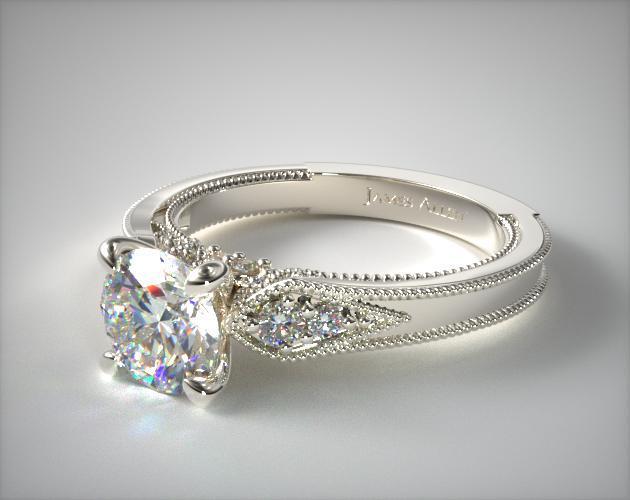
There are many reasons to add milgrain to your engagement ring design.
For one thing, milgrain adds texture to your ring, elevating a simple design into a complex, intriguing one. You may not even be consciously aware of the milgrain detailing, but even so it will add that extra touch to your ring.
Milgrain adds that vintage look to even modern rings, creating a beautiful and harmonious interconnection between modern and older eras in jewelry designs.
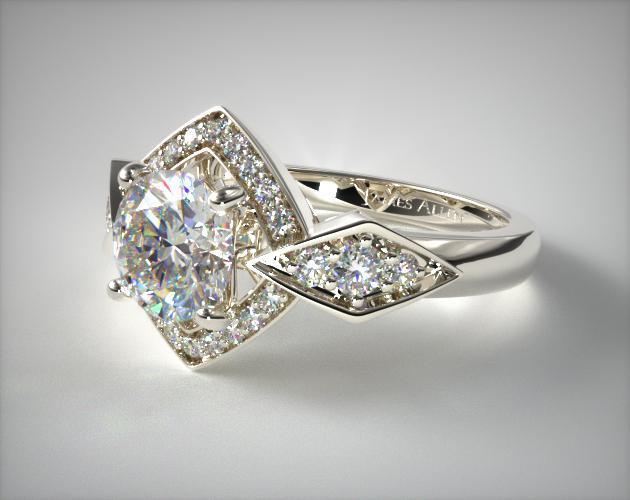
Milgrain can act like a frame for gemstones or fancy metalwork in your ring design, promoting the beauty of these aspects and guiding your eye towards them. This is perfect for engagement rings where important aspects of the design can be subtly highlighted.
For some, milgrain gives a touch of artisanship, appearing unique like a hand-crafted piece, even if it is machine made. This explains one reason why many gravitate towards milgrain detailing.
The Trouble with Milgrain
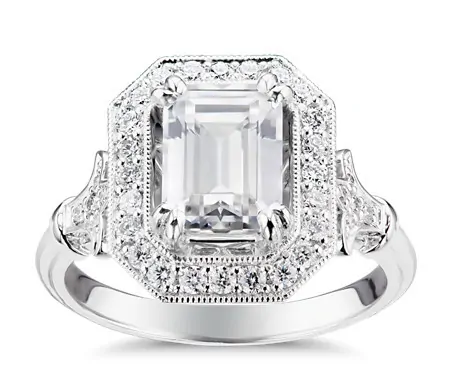
Milgrain detailing in engagement rings needs to be maintained in order to keep the piece looking picture perfect.
The problem is that over time and with frequent exposure, milgrain can slowly wear off, losing its definition. This is not the end of the world. You may simply have to take the ring to a professional to have the milgrain restored every ten years or so. Restoring milgrain in jewelry is also relatively inexpensive.
Another issue with milgrain is that it’s harder to keep clean compared to most other designs. Dirt can get lodged tightly among the milgrain beads. When this happens, your ring will look dull and lose its sparkle. Again, it’s not a huge deal – you’ll just have to clean the ring periodically. Mild soap and warm water together with a soft cloth or brush should do the trick to remove dirt build-up on your milgrain ring setting.
Other Vintage Elements on Rings – What Are Your Options?
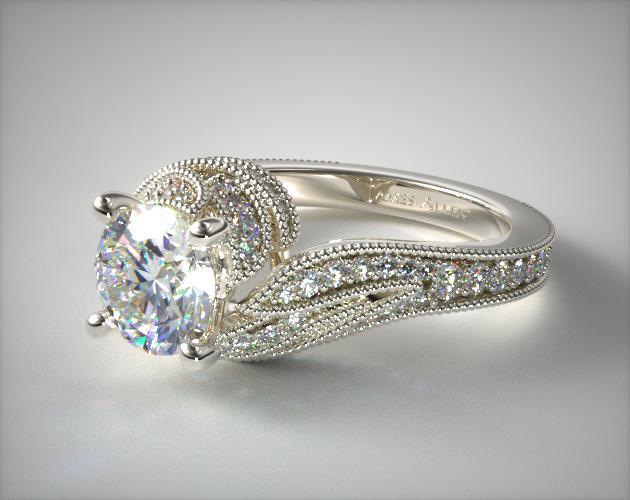
While milgrain is one of the most popular ways to add a vintage touch to your ring, there are other elements that you can use as well. These can be used alone or together with milgrain.
- Filigree: This technique uses thin metal threads and elegant motifs to create intricate patterns. Filigree is one of the most popular techniques used in vintage inspired designs, like this gorgeous ring.
- Guilloché: This is a technique in which a precise, intricate pattern is mechanically etched into an underlying material with very fine detail. Often covered with translucent enamel, the result is a detailed and vibrant design, like this stunning vintage pearl ring.
- Repoussé: Repoussé is a technique where metal is shaped from the reverse side to create a design in relief. It’s a form of embossing. You can see an example of this technique in this Chinese opera ring.
Where to Buy Milgrain Engagement Rings
Because vintage-inspired designs are highly sought after, most retailers have a vintage engagement ring collection. Many of these feature milgrain detailing. If you’re buying at your local store, then it’s best to check their reviews, compare their services and check the quality of their products. Here are the stores we’d recommend checking out if you’re buying online.
Why: Superior diamond imaging, competitive prices, high quality, wide range
An online giant in the diamond space, James Allen has a stunning collection of high-quality diamonds and quality milgrain jewelry. The images and videos are unparalleled in quality and makes shopping online similar, if not better, to shopping in store.
Why: Competitive prices, wide range, great quality
Known for dominating the online diamond industry since the late 1990s, Blue Nile offers one of the largest online diamond and ring setting inventories. Search diamonds and settings here at competitive prices, solid after-sales policies, and great customer service.
Why: Superior cut quality, exclusive range, stunning designs
Whiteflash has earned an international reputation for the elite quality of their precision cut diamonds, and for their impeccable collection of designer engagement rings. Check out their stunning range of diamond jewelry and loose diamonds.
Why: Impeccable quality, superior cut, small but exclusive inventory
Brian Gavin is a renowned expert in diamond cut – and it shows in their superior diamond quality. For the very best in diamonds, search their inventory of designer diamond jewelry and loose diamonds.
Why: Try before you buy, build your own ring, great quality
If you want to try out how a princess cut diamond ring looks on your finger before you commit to buying one, check out With Clarity’s Home Preview Service which is completely free. Find out more here.
Wrapping Up
By selecting a milgrain engagement ring, you’re choosing a style that’s steeped in history and ornate detail. Milgrain engagement rings offer a vintage appeal and intricate detail that’s truly enchanting, lending a unique charm to your symbol of commitment.
However, the tiny granules may require extra cleaning, and the vintage style might not appeal to everyone. Ultimately, the choice depends on your personal taste, balancing the desire for distinctiveness against maintenance considerations.


